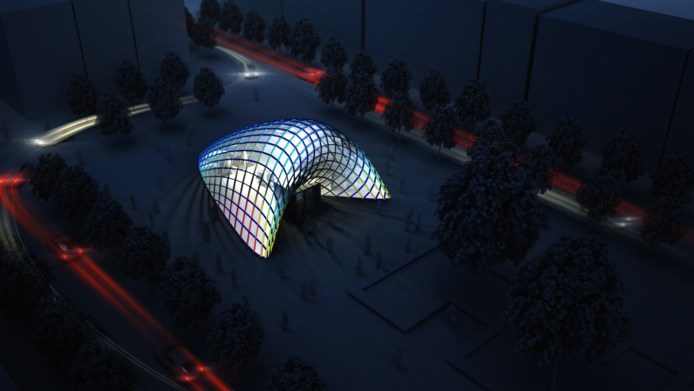New architecture with maths

Latest the Guggenheim Museum in Bilbao, Spain, demonstrated how impressively building structures can free themselves from the confines of a traditional form of vocabulary. And specialised computer programmes that translate architects' creative ideas into enthralling renderings, are the key to this development. The discipline of freeform architecture which emerged from such programmes is still in its infancy. With the support of the FWF researchers at the Vienna University of Technology are currently making an important contribution to developing the opportunities offered by this exciting branch of architecture.
Form follows research
The trend for freeform structures in contemporary architecture is actually creating several challenging research problems. Some of them can be solved using differential geometry – a mathematical discipline – as Helmut Pottmann, who heads the FWF project, in the interview with scilog explains: "For cost and planning reasons, even the most creative freeform structure must be composed of the simplest and most standardised components. Planning this is clearly a job for discrete differential geometry. In this field of geometry, curves and surfaces are discretised, in other words mathematically broken down into simple, flat elements. This radically reduces the variables that need to be calculated", explains the mathematican. The fragmented elements, known as panels, can be selected in such a way that they also meet the specific requirements for the aesthetic or the building physics. If such a fragmentation is rendered, it appears like a fine-mesh woven fabric that can be used as a model calculation for every conceivable form.
Network of research
The mathematical representation of such meshes is the focus of the research conducted by Pottmann and his team. Over the course of the FWF project, the group has succeeded in making significant progress. For example, it was able to extend the calculation of discrete surfaces to include hyperboloid surface parts, as they are known. These can be used to produce smooth freeform surfaces, such as facades, from simple panels. The group developed an interactive design tool that can calculate the forces of equilibrium at the edges of discrete surfaces. The team also developed another tool that can account precisely for the forces of equilibrium in shells. This was previously only possible in an approximate, limited or very time-consuming way. The interactive possibilities offered by this tool have already been integrated into wider architectural applications. This is clear evidence of the high level of practicality of the developed calculation model.
Research as a foundation
Pottmann's main focus is always on the application of the initially purely mathematical developments. He refers to very specific problems in freeform architecture: "It is exceedingly desirable in steel-glass constructions that the steel beams meet cleanly at one node rather than meeting randomly. This sounds easy, but it is anything but easy to plan if the architecture is following a freeflowing form. These are exactly the types of problems that our research helps to resolve." In fact, many programmes used for developing designs do not take into consideration specific structural requirements. Many of them are based on the principles of mass production where very different manufacturing methods are more beneficial than the methods used for architectural one-offs. Real-world programmes for freeform architecture must therefore allow for the division of forms into panels as much as for the design of a substructure and the incorporation of the properties of various building materials – and all of that for specific geometric problems. After allowing for all these factors, the form originally desired should be rendered as faithfully as possible. Not all the mathematical answers to these architectural challenges have yet been found. But the work being done by Pottmann and his team is laying a solid foundation for the future creativity of architects.
Personal details Helmut Pottmann is a professor and Head of the Center for Geometry and Computational Design at the Technische Universität Wien. He is an international pioneer in the architectural application of discrete differential geometry and was Director of the Center for Geometric Modeling and Scientific Visualization, King Abdullah University of Science and Technology in Saudi Arabia between 2009 and 2013.
Publication





